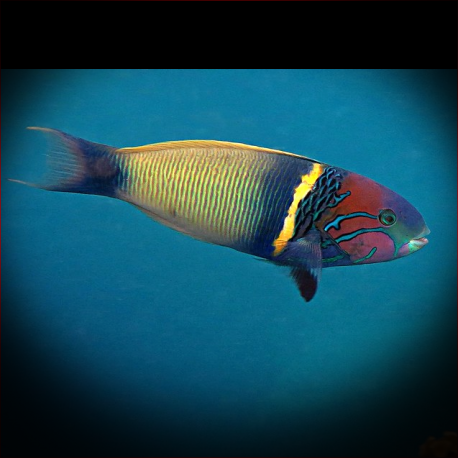More info
Datasheet
| Minimum Tank Size | 800 litres / 211.34 US gallons |
| Maximum Size | 23.0cm / 9.06inches |
| Reef Compatible | Reef safe with caution |
| Temperament | Might be aggressive towards other species |
| Temperature | 22.2°C / 71.96°F - 25.6°C / 78.08°F |
| Specific Gravity | 1.020-1.025 |
| Carbonate Hardness | 8-12 |
| pH | 8.1-8.4 |
General Description
The Goldbar wrasse (Thalassoma hebraicum) is a species belonging to the Labridae family. These fish are visually appealing both as juveniles and adults, with distinct appearances at different life stages. They have a diverse diet ranging from small prey like Artemia to larger invertebrates such as snails, crustaceans, and sea urchins. Goldbar wrasses display aggressive behavior towards smaller tank mates and require adequate feeding due to their high activity levels.
Aquarium Suitability
Considered suitable for aquariums with caution, the Goldbar wrasse can be aggressive towards smaller fish, snails, and crustaceans, needing ample space to thrive. They demand a large aquarium when fully grown, making them challenging to house in a typical home aquarium. Frequent feeding at least twice daily is necessary due to their active nature, and they thrive best in setups that offer hiding spots and plenty of swimming space.
Care and Hardiness
Goldbar wrasses are categorized as hardy fish and can adapt well to varying water conditions within the recommended ranges. They are known to jump out of open tanks, emphasizing the need for secure aquarium lids. These wrasses are hermaphroditic, capable of changing gender as needed, and may exhibit aggressive tendencies if not provided with sufficient space and a diverse diet.
Reef Suitability
With caution, Goldbar wrasses are considered reef-safe, but their aggressive nature towards smaller creatures like snails and crustaceans warrants careful consideration when adding them to a reef environment. They can contribute to parasite control on reef fish but may not significantly impact large outbreaks of parasites like marine Ich.
Aquarium Setup
Setting up an aquarium for Goldbar wrasses should include a secure lid to prevent jumping incidents. Providing hiding spots among live rocks is essential for their well-being. A sandy substrate, although not mandatory, may mimic their natural habitat. The tank should offer ample swimming space and accommodate their need for frequent feeding and varied diet.
Behaviour
Goldbar wrasses exhibit territorial and sometimes aggressive behavior, particularly towards smaller tank mates. They can be kept in pairs, with one male and one female, offering interesting social dynamics within the aquarium. Known for their active swimming behavior, these fish require a setup that allows them to roam freely.
Feeding and Diet
Their diet consists of larger crustaceans, other invertebrates, small crustaceans like krill and mysis, and zooplankton. Goldbar wrasses require regular feeding to meet their nutritional needs and should be provided with a varied diet to ensure their overall health and well-being.
Habitat and Distribution
Goldbar wrasses are found in the Western Indian Ocean, typically inhabiting regions south to Algoa Bay in South Africa. They live in a range of environments, from sandy substrates to rocky areas, where they can hide and forage for food. In aquariums, mimicking their natural habitat through appropriate decor and structure can help promote their overall health and behavior.

